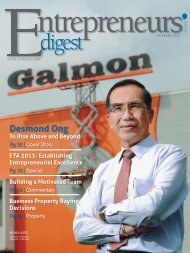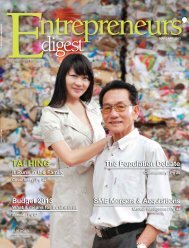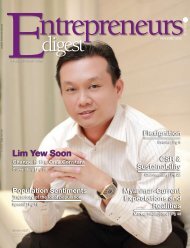ED 44
Create successful ePaper yourself
Turn your PDF publications into a flip-book with our unique Google optimized e-Paper software.
42<br />
mA r k E t in t E l l i gE n C E<br />
Market Potential<br />
Much like Vietnam, Laos and Cambodia, Myanmar is filled with<br />
opportunity and promise in its lush forestry and rich port areas.<br />
At this point in time, even if several market sectors have already<br />
been developed – to a reasonable degree at least – the fact<br />
still remains that plenty of key areas within the country require<br />
added focus and concern.<br />
“Myanmar looks very tempting at first glance but we have to<br />
remember that there are wealthy Burmese who can compete<br />
with foreign investors, unlike Vietnam in the early days where<br />
both the State owned companies and family companies were<br />
not rich,” said Mr Rick Mayo-Smith, president of investment<br />
management firm Indochina Fund Management Pte Ltd.<br />
Indeed, the business environment is still challenging to say<br />
the least, and is expected to remain so for the near future. By<br />
way of background, Myanmar is ranked close to last on the list<br />
of Transparency International’s Corruption Perceptions Index<br />
(180th of 182) and is not even mentioned in the World Bank’s<br />
Doing Business report.<br />
In the same vein as other resource-rich emerging markets like<br />
Mongolia, Myanmar is projected to veer towards the area of<br />
commodity extraction and the infrastructure required in getting<br />
all produce to market. Therefore, investors will be focused<br />
on the infrastructure, mining and oil & gas industries for the<br />
foreseeable future.<br />
“Myanmar is a frontier market, it is not like Vietnam in the 1990s<br />
or Cambodia in early 2000s; there are similarities but not the<br />
same,” according to Mr Thura Soe-Paing, Managing Director of<br />
investment and advisory firm All Myanmar Investment Partners<br />
(AMIP), “So people considering doing business in Myanmar<br />
should do their homework and not just merely cut-and-paste<br />
of what has happened before.”<br />
Market Sectors<br />
Infrastructure is one of the biggest gaps in the market containing<br />
the most potential for development. In Myanmar currently,<br />
only 12% of all roads are paved and 50% of all goods are<br />
still transported via river barges, allowing immense business<br />
potential in road infrastructure, with projects linking Myanmar<br />
to the border nations being most financially sustainable.<br />
Nevertheless, perhaps the biggest problem plaguing business<br />
in Myanmar is the lack of a reliable power supply, with only 20%<br />
of the total population connected to the national power grid.<br />
Currently, the power industry is the dominant market segment<br />
in the Burmese business landscape, commanding 40% of<br />
total market share. All things considered, the power industry<br />
itself can be a viable market, with off-grid generation sources<br />
like thermal power plants being the most feasible, along with<br />
renewable power plants even if hydropower facilities have fallen<br />
out of favour.<br />
Although Myanmar has broadband internet capability, the<br />
service is not freely available to the masses, with only around<br />
Ju l | Au g 2012<br />
En t r E p r E n E u r s’ Di g E s t<br />
100,000 of the 60 million-population connected to the internet.<br />
More mobile phone towers are needed in addition to the<br />
phasing out of dated SIM cards that cost US$400 apiece and<br />
can only be used within Burmese boundaries.<br />
Agriculture is the mainstay of the Burmese economy, existing<br />
throughout the history of the nation and with more than half of<br />
the population practice farming to varying degrees. However,<br />
land reforms and upgraded machinery are sorely needed<br />
to bring this market sector to the next level. Similarly for the<br />
construction industry, existing infrastructure must be upgraded,<br />
or even rebuilt if necessary.<br />
Manufacturing is another area worthy of consideration. With<br />
wages less than a third of those in Thailand and even China,<br />
textiles and other lower-end manufacturing businesses can<br />
stand to benefit. For the textile industry, wages can be as low<br />
as US$20 a month and the relaxation of US sanctions will give<br />
the industry an added boost, since 75% of all Burmese textile<br />
exports are bound for the USA.<br />
On tourism, Myanmar can be considered an idyllic location,<br />
even if it pales in comparison to its other ASEAN neighbours.<br />
Visitor arrivals have been on the rise since 2008, and 500,000<br />
tourists are expected to visit Myanmar in 2012. Its numerous<br />
pagodas, temples, mountainous regions as well as beach<br />
resorts certainly create a scenic tourist destination, only<br />
hampered by a lack of capacity and potential supply issues in<br />
both the high and low-end hotels.<br />
Myanmar has the 4th largest copper mine in Asia, delivers<br />
60% of the world’s teak, and is also responsible for 90% of












